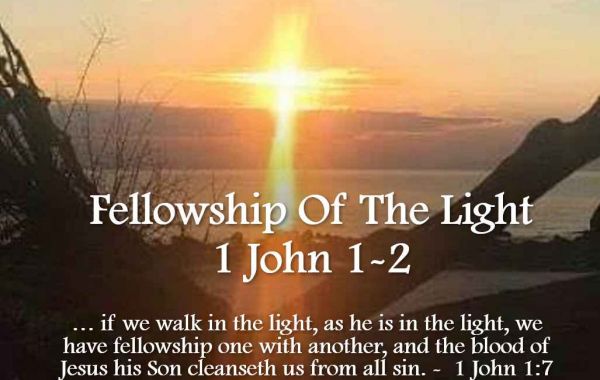John, The Last Apostle and the Fellowship of Light
John may have been much younger than His Lord, whatever his age actually was we can be pretty sure that since Jesus probably began his ministry at 30, the age when a man was qualified to served in the Temple, its very probably that his apostles would have been around that age or younger. By the time John writes his epistles, he is the last surviving apostle. He calls himself the elder and the aged. It is thought that he may have been close to 90 years old.
In the age we live in, it sometimes seems that everything we once thought was true and unshakeable about our doctrine, about our churches, about our nations and our families is now rapidly changing. Suddenly nothing is sure, truth is no longer truth, right is no longer desirable and wrong accepted as a necessary human right. As unsettling and disheartening as this is for us, can you imagine what it was like for the last living apostle, John. Everything and everybody that once were a steadfast part of his life are now gone. His brother James, killed by the Pharisees while still a young man back in Jerusalem. His fishing partners and later his coworkers in the work of carrying the Gospel, Peter and Andrew, both gone. No apostles left, Paul is gone and as far was we can tell from the letters none of the other building blocks of the New Testament are living. No mention is made of Mark, Luke, Barnabas, or Silas. In their place there is a new generation of pastors and workers that John is trying to teach.
On top of the loss of his family and fellow apostles, the truth of the Gospel and even the Person of his Lord and Savior is under attack, often by those who dare to call themselves, Christians. Toward the end of the first century a new false Christianity, called Gnosticism, was making inroads into the churches. The Christianity that turned the world upside down in the first half of the century, was now at risk of being turned upside down itself.
Gnosticism, was a philosophy of existence or being. It involved speculations concerning the origin of matter and how human beings can be free from matter. In particular, Gnosticism held that knowledge is superior to virtue, that the nonliteral sense of Scripture is the true meaning and can be understood only by a select few, that evil in the world means God’s could not be the creator, that the Incarnation was impossible because deity cannot unite itself with anything material—such as a body, and that there is no resurrection of the flesh. This teaching resulted in beliefs like Jesus not being a human at all but was merely a prolonged theophany, or that Jesus was the natural son of Joseph and Mary, upon whom Christ came at the time of baptism. Some Gnostics practiced asceticism because they believed all matter to be evil. Antinomianism, or lawlessness, was the conduct of others, since they held knowledge to be superior to virtue. - Wycliffe Bible Commentary
In spite of all the things that seemed to be changing the very foundations of Christianity, John knew that the truth hadn’t changed and can’t change. That Jesus the son of God, very God of very God, God in the flesh had not changed that he was the same, yesterday, today and forever and so John writes these letters to strongly and boldly proclaim again, the truth of Jesus Christ.
1 John 1:1-4 That which was from the beginning, which we have heard, which we have seen with our eyes, which we have looked upon, and our hands have handled, of the Word of life; (For the life was manifested, and we have seen it, and bear witness, and shew unto you that eternal life, which was with the Father, and was manifested unto us;) That which we have seen and heard declare we unto you, that ye also may have fellowship with us: and truly our fellowship is with the Father, and with his Son Jesus Christ. And these things write we unto you, that your joy may be full.
The Person. 1:1-2
John names Jesus as the Word, the Logos. With this name, this title, John is declaring the reality, the truth, of the revelation of God in the person of Jesus. John then gives his witness of his own personal, first-hand experience of his life and time with Jesus of Nazareth, son of Mary, raised by his earthly father Joseph. John, heard him teach in the synagogues, he heard him preach the Sermon on the Mount, He saw Him heal the sick, give sight to the blind, cast out demons, walk on water, calm the storm, feed thousands with only a few loaves and fishes. John saw this same Jesus raise Lazarus from the grave. Then he saw Him beaten, tortured, humiliated and then crucified on a Roman cross and then he saw his Lord die and all the earth turn to blackness. But that was not the end of what John had personally seen. Oh, no. For 3 days later, he heard the reports of Mary, ran to see the empty tomb and then, and then he saw Jesus alive, returned from the dead victorious in glory, power and light. Finally, on Mt Olivet, he watched as Jesus ascended back into the throne room of heaven and heard the promise of His return.
John in his Gospel and in these letters stands and says, “My eyes have seen him. My hands have touched him. He is the Word of life!”
The Purpose. 1:3-4
Now John writes the next generation of believers, some at risk of the lies and seduction of a false knowledge, a gnosis, that was not based in truth or reality and not proven by first hand eye-witness accounts, but on a philosophy that masqueraded as a new, better, deeper, more fulfilling way, but in truth it was pure deception. It is still with us in many forms, but this also hasn’t changed it is still a deception, still and error, still a lie and not the truth.
Procurar
popularne posty








